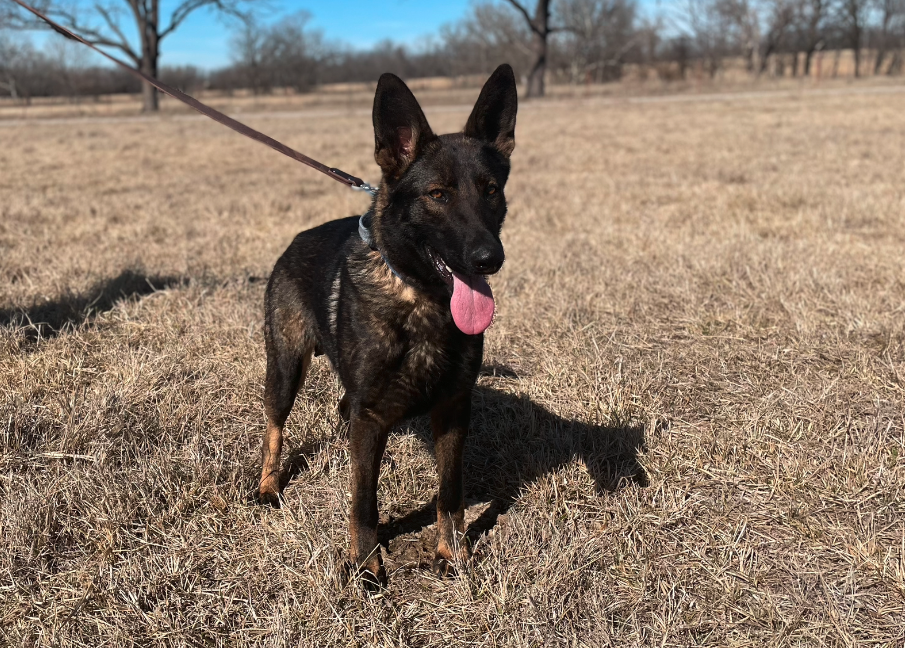German Shepherd Breed Standard
Czech Working Line breeds to conform to the International working line German Shepherd breed standard.
A historical overview of the German Shepherd Dog breed standard.
The Verein fur Deutsche Schaferhunde (SV), short for the Society for German Shepherd Dogs. Founded in April 22, 1899 by Captain Emile Stephanitz and Artur Meyer, the original goal of this society was to establish a reference guide for German Shepherd Dog breeders in developing the breed. The first headquarters was located in Stuttgart, Germany. Once agreed upon, this standard was then presented to and agreed upon by the German Kennel Club (VDH).
With its first meeting held on the 20th of September 1899, Stephanitz’ and Meyer’ as the SV’s first members began with proposals and recommendations for the establishment of the GSD breed standard. In short order, additional members were added to the SV. Early meetings proposed a plan to more effectively communicate and establish the breeding standard. We see this taking shape right at the turn of the 20th century. A second historic moment in the development of the German Shepherd breed standard was the formation of the World Union for German Shepherd Dog Clubs (WUSV). The first meeting took place in Augsburg, Germany in 1968. Further meetings in 1974 and again in 1975 brought the WUSV into fruition. The WUSV has now grown to include 95 members in 88 countries. In it’s own words, one of the WUSV’s critical goals has been to maintain a “uniform breed standard, comparison of positions and the evaluation of German Shepherds in breeding and performance, clarification of open questions about breeding and training, upbringing and keeping as well as the abatement of hereditary diseases.” To read more on the official position of the WUSV, see here. Here at Czech Working Line we have occasional litters of working line German Shepherd puppies for sale. Call us for information on these litters.
International German Shepherd Breed Standard (credit to the United Schutzhund Club of America. See here for more information on their breed standard.
“General Appearance
The German Shepherd is a medium size dog, slightly stretched, strong, dry and well muscled, with strong bones, whilst the whole body must appear compact.
Important Size Proportions
At the wither, the measurement must be between 60-65 cms in males and 55-60 cms in females. The body length must surpass the wither height by between 10-17%.
Character
The German Shepherd must be self assured, balanced with dry nerves (calm disposition and not nervous) and absolutely impartial behaviour, whilst maintaining a good nature – until pushed to the limit. The dog must be vibrant and easygoing. Furthermore the dog must be courageous, have a strong fighting instinct and possess firm nerves. These are essential requirements since the dog is to be used as companion, guardian, protector and a working sheepdog.
Head
Head must be wedge shaped and proportionate in size to the rest of the body (the length of the head should be approximately 40% that of the wither height), without appearing clumsy, shapeless or coarse or over-long. The general appearance must be dry (no flabby, loose skin). The forehead (whether seen from the front or the side), should not appear to be domed and have only little or no centre furrow.
The ratio between the forehead and the end of the muzzle must be almost 50/50. The forehead width must be the same as it’s length. The skull (seen from the top), from the ears to the tip of the nose must consist of smooth lines, whilst having a defined separation between the skull and the muzzle (stop).
The Nose
Nose be black pigmented.
The Mouth
Mouth must be strong, well-developed, healthy and complete (42 teeth in total). The German shepherd must have a scissor-like bite, in other words the bottom teeth locking with the top teeth in a scissor-like formation. Furthermore, the upper jaw must overlap the bottom jaw. The definition on the side of the jaw, is positioned in such-a-way, so as the top and bottom layers of the front teeth (top and bottom) must not shut level (directly on top of the other) – the top must over-lap the bottom in a scissor-like close. The bones of the jaws must be well developed so as the teeth are not prematurely worn.
The Eyes
Eyes must be neither large nor small in size— medium sized, almond-shaped and slightly angled, whilst they must not protrude. The eye colour should be as dark as possible. Light eyes are undesirable as they spoil the expression of the dog.
The ears should be set high on the skull and carried almost parallel.
Ears
The German Shepherd has ears must be of medium sized, firm textured, broad at the base, set high on the skull, are carried erect (almost parallel and not pulled inwards), taper to a point and open towards the front. Tipped ears are faulty. Hanging ears are a very serious fault. During movement the ears may be folded back.
Neck
The GSD’s neck must be strong, well muscled and without excessive, loose skin at the throat. It should be at a 45° angle to the body.
Body
The body must display a smooth top line beginning from the back of the neck and continuing in a straight line over a well developed wither and sloping slightly toward the croup – without any visible disturbance. The back is tight, strong and well muscled. The loin is broad, well developed and well muscled. The croup must be long and slightly angled (about 23° to the horizontal), without any disturbance to the topline – it must continue toward the beginning of the tail.
The Chest
Chest will be moderately broad and the brisket should be long and pronounced. The depth of the chest should not be more than 45-48% of the wither height.
Ribs
Ribs must show a modest curve. It is faulty for the ribs to be either barrel shaped (too round) or slab sided (too flat).
The Tail
The tail must be bushy haired on the underside, should reach at least to the hock joint. The ideal length – being to the middle of the hock bones. When at rest the tail should hang in a slight curve like a sabre. When moving it is raised and the curve is increased. Surgical corrections are not permitted.
Forelimbs
German Shepherd Dog forelimbs – when seen from all sides must be absolutely straight. Viewed from the front, they must be parallel. The shoulder blade and the upper arm must have the same length, be well muscled and be tightly knit to the body. The angle of the shoulder blade to the upperarm – ideally should be at 90° but usually it is acceptable around 110°. The elbows must be close to the body – both in stance and in movement.
The pastern must be 1/3 of the length of the foreleg and an angle of about 20° – 22° to foreleg. Furthermore the pastern should be neither too straight nor too angled (say 20-22°), so as not to deter the dogs stamina.
The Feet
Feet should be rounded, toes well closed and arched. Pads should be well cushioned and durable but not brittle surfaced. Nails short, strong and dark in colour.
Hindquarter
The standard requires position of the hindquarter bones are rounded toward the back. When viewed from the back, they are parallel to each other. The upper and lower thigh bones are almost of the same length and create an angle of approximately 120°. The tight must be strong and well muscled. The hock joint must be strong and tight, whilst on a vertical line to the rear feet.
Gait
The German Shepherd Dog is a trotting dog. To achieve this, the limbs must be in such balance to one another so that the hind quarter may be thrusted well forward to the mid-point of the body and have an equally long reach with the forefoot and without any noticeable change in the back line.
The correct proportion of height to corresponding length of limbs will produce a ground-covering stride giving the impression of effortless movement. The head thrust forward and tail slightly raised – balanced and even trotting is seen with a flowing line, running from the tips of the ears over the neck, back and the tip of the tail.
The Skin
The German Shepherd breed standard requires the skin be tight, lacking in wrinkles.
Coat
The German Shepherd coast must display a consistency in the hair: The correct hair type for the German shepherd consists of the undercoat and an overcoat. The overcoat must be made up of dense, straight – hard and close-lying hairs. The hair on the head, ears, paws and legs must be longer and even denser. The hair at the back of the hind legs form a moderate “trouser”.
Color
The German Shepherd breed standard requires the color should be black with markings of brown, red-brown, blonde and light grey. Alternatively a grey base-colour with “clouds” of black markings and a black “saddle” and “mask”. Inconspicuous white markings on the chest, and “brighter” shades on the under- and inner sides of the dog are permitted but not desirable. The nostrils must in all cases be black.
Non-existence of a “mask”, bright – until piercing eye colour as well as light/white nails and are coloured tail top are considered as a lack of pigmentation, the undercoat is a slight gray fond. White is not permitted.
Testicles
Male German Shepherd Dogs must have two, normal testicles fully which are fully developed in the scrotum.
Faults
Any departure from the foregoing points should be considered a fault and the seriousness with which the fault should be regarded should be in exact proportion to its degree.
Serious Faults
Any departure from the breed standard which has been stated in this standard and which affects the usefulness and appearance of the dog, is considered a serious fault. Lacking of pigmentation, heavy and loose dogs, missing or faulty dentition and/or jaw formation.
Faults Of The Ears
Ears set too low off the side of the skull, soft and tipping at the tops (friendly ears).
Exclusion Faults
- Dogs with weak character who are nervous or nervous biters.
- Dogs with proven (documented) a serious hip dysplasia (HD) condition.
- Dogs with Monorchids, cryptorchids or deformed testicles.
- Deformed ears or tails.
- Dogs with physical deformities.
- Dogs with dental deficiencies.
- Dogs with jaw deficiencies (under- or over shot mouths).
- Dogs that are oversized/undersize by more than 1 cm from the set standard.
- Dogs with Albinism
- Dogs with white hair color (regardless if the nose/eyes are dark).
- Dogs with long coats (where the hair is soft, long, not tight — especially noticeable long inside and on the outside of the ears, long hair behind the front and rear legs, long hanging hair hanging from the tail).
- Dogs with long coats andno undercoat, where the hair from the back is parted in the middle and hangs down the side of the dog.” See here for more information on the United Schutzhund Clubs of America (USCA) breed standard.

